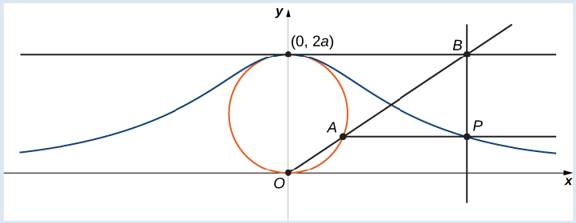
The Witch of Agnesi
Many plane curves in mathematics are named after the people who first investigated them, like the folium of Descartes or the spiral of Archimedes. However, perhaps the strangest name for a curve is the witch of Agnesi. Why a witch?
Maria Gaetana Agnesi (1718—1799) was one of the few recognized women mathematicians of eighteenth-century Italy. She wrote a popular book on analytic geometry, published in 1748, which included an interesting curve that had been studied by Fermat in 1630. The mathematician Guido Grandi showed in 1703 how to construct this curve, which he later called the “versiera,” a Latin term for a rope used in sailing. Agnesi used the Italian term for this rope, “versiera,” but in Latin, this same word means a "female goblin.” When Agnesi’s book was translated into English in 1801, the translator used the term “witch” for the curve, instead of rope. The name “witch of Agnesi” has stuck ever since.
The witch of Agnesi is a curve defined as follows: Start with a Circle of radius a so that the points (0, 0) and (0, 2a) are points on the circle (Figure 7.12). Let O denote the origin. Choose any other point A on the circle, and draw the secant line OA. Let B denote the point at which the line OA intersects the horizontal line through (0, 2a). The vertical line through B intersects the horizontal line through A at the point P. As the point A varies, the path that the point P travels is the witch of Agnesi curve for the given circle.
Witch of Agnesi curves have applications in physics, including modeling water waves and distributions of spectral lines. In probability theory, the curve describes the probability density function of the Cauchy distribution. In this project you will parameterize these curves.

On the figure, label the following points, lengths, and angle:
a. C is the point 011 the x-axis with the same x-Coordinate as A.
b. x is the x-coordinate of P, and y is the y-coordinate of P.
c. E is the point (0, a).
d. F is the point on the line segment 0A such that the line segment EF is perpendicular to the line segment OA.
e. b is the distance from O to F .
f. c is the distance from F to A.
g. d is the distance from O to B.
h. θ is the measure of angle
The goal of this project is to parameterize the witch using θ as a parameter. To do this, write equations for x and y in terms of only θ.
Want to see the full answer?
Check out a sample textbook solution
Chapter 7 Solutions
Calculus Volume 2
Additional Math Textbook Solutions
Thinking Mathematically (6th Edition)
A Problem Solving Approach To Mathematics For Elementary School Teachers (13th Edition)
University Calculus: Early Transcendentals (4th Edition)
Introductory Statistics
Calculus: Early Transcendentals (2nd Edition)
- Direction: Strictly write in 4 bond paper, because my activity sheet is have 4 spaces. This is actually for maritime. industry course, but I think geometry can do this. use nautical almanac. Sample Calculation (Amplitude- Sun): On 07th May 2006 at Sunset, a vesel in position 10°00'N 0 10°00' W observed the sun bearing 288° by compass. Find the compass error. LMT Sunset 07d 18h 13m (+)00d 00h 40 м LIT: UTC Sunset: 07d 18h 53 m added - since longitude is westerly Declination Co7d 18h): N016° 55.5' d(0.7): (+) 00-6 N016 56.1' Declination Sun: Sin Amplitude Sin Declination (Los Latitude - Sin 016° 56.1'/Cos 10°00' = 0.295780189 Amplitude = WI. 2N (The prefix of amplitude is named easterly if body is rising. and westerly of body is setting. The suffix is named came as declination.) True Bearing: 287.20 Compass Bearing 288.0° Compass Error: 0.8' Westarrow_forwardOnly 100% sure experts solve it correct complete solutions need to get full marks it's my quiz okkkk.take your time but solve full accurate okkk maths expert solve itarrow_forwardI have ai answers but incorrectarrow_forward
- Suggest to geometry subject expertsarrow_forwardDo 10000%. Correct complete solutions without guidelines okkarrow_forwardOnly 100% sure experts solve it correct complete solutions need to get full marks it's my quiz okkkk.take your time but solve full accurate okkk Geometry expert solve itarrow_forward
- Algebra & Trigonometry with Analytic GeometryAlgebraISBN:9781133382119Author:SwokowskiPublisher:Cengage
 Mathematics For Machine TechnologyAdvanced MathISBN:9781337798310Author:Peterson, John.Publisher:Cengage Learning,
Mathematics For Machine TechnologyAdvanced MathISBN:9781337798310Author:Peterson, John.Publisher:Cengage Learning, Elementary Geometry For College Students, 7eGeometryISBN:9781337614085Author:Alexander, Daniel C.; Koeberlein, Geralyn M.Publisher:Cengage,
Elementary Geometry For College Students, 7eGeometryISBN:9781337614085Author:Alexander, Daniel C.; Koeberlein, Geralyn M.Publisher:Cengage,  Functions and Change: A Modeling Approach to Coll...AlgebraISBN:9781337111348Author:Bruce Crauder, Benny Evans, Alan NoellPublisher:Cengage Learning
Functions and Change: A Modeling Approach to Coll...AlgebraISBN:9781337111348Author:Bruce Crauder, Benny Evans, Alan NoellPublisher:Cengage Learning



